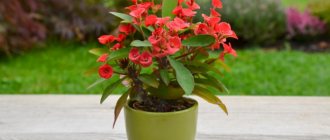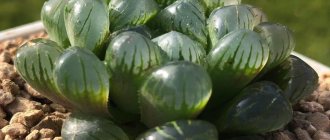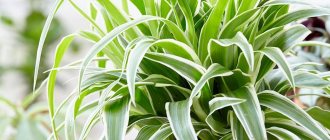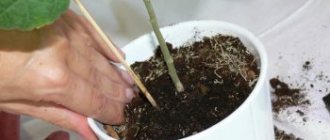Water hyacinth
The bizarre flower is found naturally in Brazil and South America. It grows on the surface of reservoirs and produces blue or purple spike-shaped inflorescences.
At home, water hyacinth is grown in an aquarium. It requires good lighting, warmth and water with fertilizers. In favorable conditions, the flower grows quickly and produces new leaves.
Sand and peat are poured onto the bottom of the aquarium for rooting. The rosette should float on the surface. Its roots absorb harmful substances and heavy metals from the water.
Advantages of the method
Growing plants in water has many advantages. This method is ideal for beginners, as it does not involve complex plant care. It virtually eliminates waterlogging, root rotting and the appearance of harmful insects.
You can always watch the growth of roots through the glass and monitor the amount of water. You don't have to spend money on pots, soil or pest control products.
Plants in beautiful jars, bottles and vases will fit perfectly into the interior. You can grow them this way for years. If you want to transplant flowers from water to ground, you can do this at any time after the roots appear.
Found a violation? Report content
Tillandsia
An unusual plant takes water and substances necessary for growth from the air. Its leaves grow in the shape of a rosette. For its extraordinary ability to grow without soil, the plant is called an air flower.
For beauty, tillandsia is placed in various decorative trays, grown on a piece of bark or shell, on a tree branch or in an aquarium.
Bright light and constant exposure to water are not recommended. It is necessary to ventilate the plant so that it does not rot.
Ways to grow tillandsia
Atmospheric tillandsia is considered one of the most unusual plants. Today they are increasingly growing it at home, using it to decorate the interior. This unique plant belongs to the epiphytic plant species. That is, tillandsia grows by attaching itself to other plants. The main feature of this plant is that it has no roots. Tillandsia feeds not through the root system, like other plant species, but through the leaves. Therefore, despite the fact that a flower has no roots, it needs a kind of home in the form of another plant or a natural base. Having attached to it, tillandsia will grow beautifully and delight with its splendor. Well, as for growing methods, today a lot of them have been invented for tillandsia. For example, a flower without roots can be grown on a crystal. For this method, you just need to coat the dry root with glue and press the plant to the crystal. You can also place tillandsia on a bark panel on the wall. This living composition looks especially beautiful in combination with succulents. An equally interesting solution for growing atmospheric tillandsia is the use of wine corks. To do this, decorators simply make small holes in them and place the base of an airy flower in them. On the Internet, it is often suggested to grow tillandsia in a terrarium. the composition looks beautiful and unusual if it is supplemented with shells and stones, the same succulents, moss and pine cones.
Tillandsia will be discussed in more detail in this video.
Orchid
An epiphyte, in nature it grows not on the soil, but on other plants, on their bark or on tree trunks. Thanks to the membrane covering the roots of orchids, the plant absorbs water from the air.
The flower can be purchased along with planting material (moss or stones). The orchid takes root well on the bark, but only if its roots are already strengthened.
Katran cordifolia
A large perennial that requires a significant amount of space in the flowerbed to grow. Flower growers plant it as a single planting along with ground cover or low-growing plants.
A shrub 140–200 cm high with large leaves forming a wide basal rosette. Young foliage is shiny and purple. As it grows, its color changes to black and green. The inflorescences consist of a large number of small white flowers with a pungent odor.
Katran is grown in warm, sunny areas, protected from drafts and cold winds. Nutritious and loose soil should contain a moderate amount of moisture, since the plant does not tolerate dampness.
Tradescantia zebrina
This perennial houseplant has beautiful foliage. Tradescantia is characterized by rapid growth, its stems reach a length of 180 cm. Beautiful large leaves have stripes of pink, white or purple colors.
To grow, cut a small cutting and place it in a container with water. Expanded clay or other wet substrate must be placed at the bottom.
The roots of the plant are thin, so they should not be allowed to dry out.
Types of atmospheric Tillandsias
There are about 500 species in total, but the most common epiphytic plants include the following:
- xerographics. A characteristic feature is the wide leaves. It is a perennial plant that does not require planting, but does require daily misting as all the nutrients are absorbed by the leaves. In the winter season it prefers dryness, and with the onset of summer there is an increased level of humidity;
- gardenera. It is distinguished by the presence of powerful rosettes and large leaves with a gray tint. Rosettes help drain drops of rain or dew, providing nutrition to the plant. Due to aerial roots, it is attached to trees;
- silver The shape of the leaves thickens closer to the base. They have a light gray tint. A long peduncle produces a pair of bluish flowers. The perianth is reddish in color. It is classified as an epiphyte, as it is attached to trees using aerial roots;
- Rusticum. The length of the rosette can reach up to 50 cm. The leaves have a yellowish tint. The leaves are durable. The main function is to collect moisture and nourish the plant. With the onset of flowering, a long peduncle and a large red bract appear. Small purple flowers appear from it. As a rule, flowering occurs within 2 months;
- Usniform Tillandsia. It is considered the most decorative species among all atmospheric plants. Forms thread-like shoots. The width of each leaf does not exceed 1 cm. They are covered with small gray scales. It is important to provide support so that the leaves hang beautifully. In common parlance it is called “Icelandic moss”;
- "Head of Medusa" One of the most popular types. Externally, the plant resembles an ordinary onion. The leaves begin to bend only upward. No matter how the plant is planted, it tends downwards. The inflorescences are painted in a bright red hue. Purple flowers gradually bloom;
- tricolor. It has bluish leaves that bend to the side from a large rosette. A large peduncle grows in the center. The bottom is colored green, which gradually turns into a red tint towards the top. Purple and blue flowers gradually bloom.
Dracaena Sandera
Or the bamboo of happiness. Dracaena has nothing in common with real bamboo, but is similar in appearance.
This indoor palm tree is unpretentious and hardy. Many gardeners prefer to grow it not in the ground, but by hydroponics.
The hydrogel is placed in the container and filled with water, which is added as it evaporates. Nutrients are dissolved in liquid.
For decoration, the stems are cut and even curled into a spiral.
What flowers can be grown in water?
First of all, you need to choose plants that do not require soil. These include:
- begonia;
- golden vine;
- lilies;
- geranium;
- bamboo;
- dieffenbachia;
- ivy;
- aglaonema;
- philodendron.
We have listed the most common types of houseplants that can grow in water. In fact, there are many more of them. Most moisture-loving species can be grown without a pot or soil.
It should be remembered that indoor flowers grow somewhat slower in water than in soil. But your care of green spaces is greatly simplified.
Philodendron
The leaves are heart-shaped and grow quickly. Philodendron thrives in the shade and sun and is not very demanding in terms of care. Typically, gardeners grow this crop in pots, but it grows well in a container of water.
To plant, pinch off a 15 cm long sprout from an adult plant, remove the lower leaves and place it in a bowl of water. After about 10 days, roots appear.
Isolepis
This plant looks absolutely stunning in tall pots. This is one of the most beautiful species of aquatic plants.
A student at the Vietnam Police Academy shared how she takes care of her facial skin.
“We are still friends”: Derevianko commented on the breakup with his wife
Rare shot: Viktoria Isakova showed her grown-up daughter from Yuri Moroz (new photo)
Benefits of growing microgreens without soil
- No soil - no dirt. This is an important factor when growing greens in an apartment. You don’t need to think about where to get it, how to prepare it or buy the substrate.
- Ecological cleanliness. When growing, only water is used. Accordingly, young shoots will not contain potentially hazardous substances.
- Convenience. Planted plants can be placed in any convenient place. At the same time, containers with seed material have minimal weight.
- High yield. Some microgreens have been proven to grow better without the use of soil. This applies to cabbage, wheat and kohlrabi.
My seedlings in rolling papers
I have three varieties of asters sown this way: burgundy, purple with a white center, and pink. In the same way, I sowed balsam, two types of zinnias: the low-growing Thumbelina and the tall Purple Queen, as well as the White Moon variety of tall marigolds, three varieties of low-growing nasturtiums (Kroshka, Empress, terry mixture) and 1 climbing variety - Red Emperor.
- Gardening work in November - 9 points that will preserve your garden until spring
Last year I bought morning glory seeds of the Milky Way variety: white gramophones with raspberry-lilac rays. I really liked it, so I collected seeds from it and also sowed them in a rolled-up cigarette.
The seedlings of all the flowers have grown well, and for the third day now I have been hardening them off in a wall-mounted greenhouse, leaving them even overnight. I think that in ten days, if the warm weather lasts, it will be possible to plant the seedlings in the ground. Our spring is early this year, self-sowing marigolds are already sprouting in the garden, which means that the time to plant flowers is about to come.
How to revive an orchid without roots? Several effective and proven methods!
There are situations when the plant slowly dies, but visually still looks attractive. Having received an orchid as a gift, it is not always possible to notice that the plant is suffering from rot or other diseases. As a result, a moment comes when the flower needs resuscitation. Many gardeners are faced with the fact that when resuscitating an orchid, they have to cut out almost all the roots of the plant, as they are affected by fungus or rot. What to do with an orchid in this case and how to restore a flower without roots? We'll tell you in this article!
Method of resuscitation of orchids without roots
It is important to remember that the orchid is an epiphyte. Therefore, the plant receives all its nutrition from the air, especially moisture. Optimal humidity when resuscitating an orchid is very important. There is one universal way that will help an orchid grow young and healthy roots.
It is necessary to prepare a tall vase or mug made of transparent glass for the orchid. The container must be transparent so that the light falls on the neck and roots of the plant. All these parts of the orchid are susceptible to the process of photosynthesis. The larger the plant, the more vase you should use. Ideally, the entire orchid should be placed in a vase or glass in order to create the effect of a high-quality florarium.
At the bottom of the selected container you need to fill the substrate with foam glass or expanded clay. The prepared substrate cushion must be moistened. The orchid should be placed in the container so that its neck does not touch the water. If necessary, water should be added to the container as soon as it evaporates. The container with the plant should be placed on the windowsill, but the orchid must be protected from direct sunlight. If the sun leaves burns on the root collar, then the orchid will have very little chance of surviving. At first, you can cover the container with the orchid with a bag to create greenhouse, humid conditions. All an orchid needs for resuscitation is warmth and moisture.
READ ALSO: Kalanchoe: planting, growing and care
From time to time, wipe the orchid leaves with a solution of succinic acid. To prepare it, mix a liter of warm water and an acid tablet. The product can be applied daily without getting the solution on the neck and core of the plant. If the root collar is healthy and hard to the touch, then the orchid has every chance of surviving and sprouting young roots soon.
But there are also some mistakes that should not be made when restoring an orchid. It doesn’t matter whether the orchid has roots, you should not immerse the flower in water along with the leaves or completely fill the flower with water. If the leaves are in water, the plant will not be able to breathe and will soon die. The root collar should also not be immersed in water, as it will quickly rot. Ideally, the orchid should not touch the water at all.
If you do everything correctly, your orchid will soon take root and quickly recover, growing its root system. It is not even necessary to add any stimulants to the water. The plant will be able to recover naturally. Have you had any cases of resuscitation of orchids?
Moscow sowing method
Preparation and sowing
Today I want to sow a beautiful Mexican variety of low-growing marigolds, Karina: its bushes are spreading, branched, almost spherical during flowering and strewn with simple orange flowers with a diameter of 2-3 cm.
For Moscow-style sowing, I cut out a strip of film from a milk bag: this material makes rolled-up cigarettes stable and dense. I place the film with the black side up, spread 2 layers of toilet paper on top of the film and moisten them so that they do not move off the film. While the paper is wet, I sprinkle small marigold seeds onto a saucer.
I will place them on wet paper with a wooden skewer, the end of which I moisten with water each time. Stepping back approximately 1 cm from the top edge of the film, I lay out the seeds in a row at a distance of 1 cm from each other. You need to place it sideways on damp paper: it is from there that the sprout should appear.
How to make a roll-your-own cigarette
I lay another layer of toilet paper on top of the spread out seeds and then roll the film up from end to end. I place the rolled-up cigarette with the seeds facing up in a disposable cup, into which I pour water to 1 cm in height. On top of the glass, to create a greenhouse effect for the seeds, I put a transparent plastic bag or file for papers, and in order not to forget which seeds were sown, I write the date, name of the crop and variety on the glass.
As soon as the first loops of seedlings appear, I will remove the bag, and the seedlings will grow under normal conditions until transplantation.
This is how you can grow not only garden but also flower seedlings on toilet paper in rolling papers made of film, saving space for other plants. I recommend that you use this method and wish everyone friendly shoots and lush flowering.











